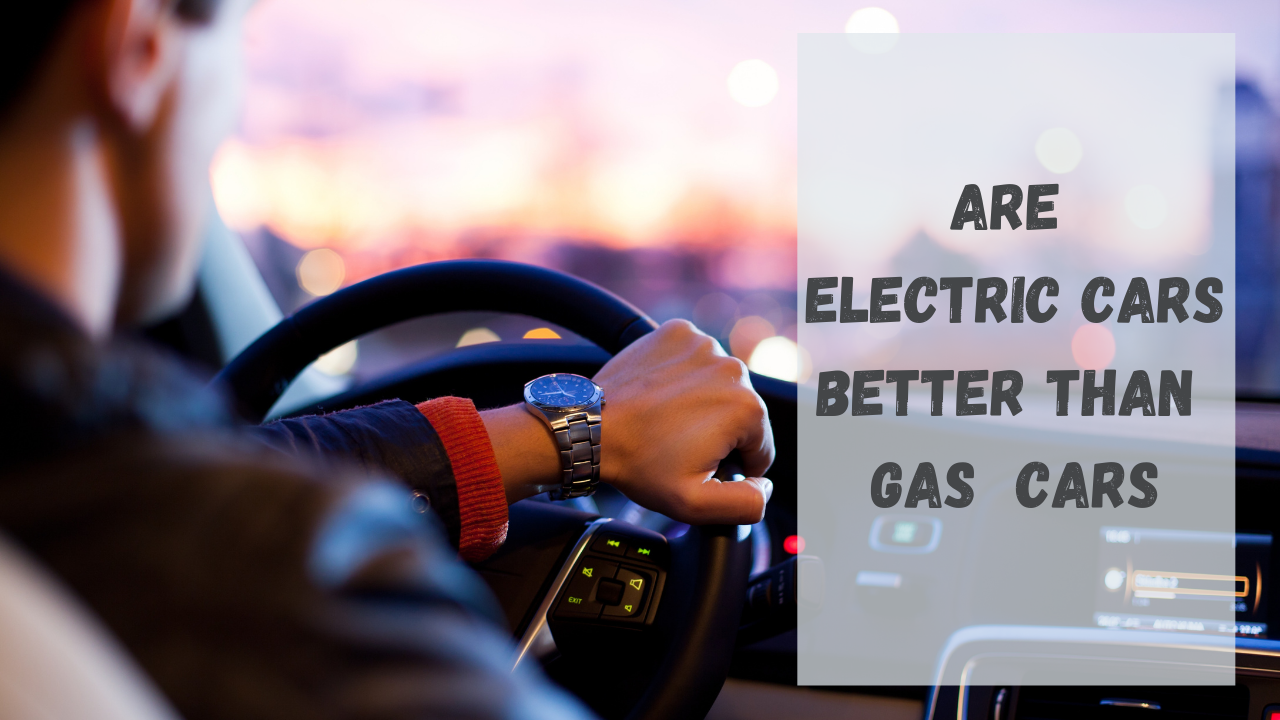One word answer is yes. Electric vehicles are becoming popular these days because of various benefits over conventional petrol or diesel engines. The advent of electric vehicles is the biggest disruption in the automotive field since ford’s assembly line concept.
But before we move forward it’s better to understand electric vehicles briefly.
Table of Contents
What is an Electric Vehicle?
Electric drive vehicles use electricity as the primary fuel. It uses electric motors or traction motors for vehicle propulsion. Electric motor source power from batteries.
Electric Vehicles first came into existence in the mid-19th century but Modern internal combustion engines have been the dominant propulsion method for motor vehicles for almost 100 years because of the lower energy density of batteries used to run electric vehicles.
With a growing focus on environmental health, electric vehicles have been becoming popular more recently. Although it’s not just the increased focus on the environment also improved electric vehicle technology(specifically improved energy density of batteries), which led to better use cases for electric vehicles.

9 Reasons why Electric cars are becoming popular these days?
1. Electric Vehicles Have Lower Running Cost
Electric vehicles are expensive to purchase initially but their running cost is Comparatively less. Moreover, the purchase cost of electric vehicles is coming down with advancements in battery technology.
For electric vehicles, the cost of charging constitutes most of its running costs. And the cost of charging depends on the means and place of charging. But one thing is for sure the cost of charging per mile in the case of an electric vehicle is much less than the cost of fuel per mile in the case of conventional petrol/diesel engines.
Although the running cost of electric vehicles varies from city to city and country to country it is approximately 0.3 times the running cost for a Diesel/Petrol Car.
2. Electric Vehicles Are Better for Environment
Increased pollution and increased carbon emissions have become a matter of big concern in recent times. Electric Vehicles are helping resolve concerns of increased pollution and increased carbon emissions.
Since electric vehicles run on electricity and do not involve any fuel burning, no CO2 is emitted while driving an electric vehicle in other words electric vehicles do not have any tailpipe emission.
The logical question here would be then how do electric vehicles contribute to carbon emissions?
It is because of the carbon emissions during the production of electricity, which indeed is used to charge electric vehicles.
Electricity can come from many sources, including from the burning of coal or gas, or from renewable sources such as solar, wind, and hydropower. Although the amount of carbon emission for which Electric vehicles are responsible is far less than those conventional vehicles are.
3. Electric Vehicles Have Lower Noise levels
Due to the absence of an internal combustion engine, electric vehicles do not have any mechanical moving parts, hence make minimal noise.
In any vehicle noise levels are contributed by three factors, engine running noise, tire resistance noise, and wind resistance noise. Engines running noise contribute maximum amongst these three factors. In Fact, wind resistance and tire resistance noise are almost negligible.
In Electric vehicles Engine running noise is eliminated, hence noise produced by electric vehicles is negligible.
Ironically, Electric vehicles are so noiseless that car manufacturers are mandated to add artificial noise under certain conditions since it being noiseless poses a danger to other road users, especially people who are blind or partially sighted.
To add artificial noise Acoustic Vehicle Alert Systems (aka, AVAS) will need to be installed in new models of hybrid and electric cars, and all existing models by July 2021.
4. Electric Vehicles Have Less maintenance cost
Electric vehicles are cheaper to maintain. Since electric vehicles do not have multiple moving parts, wear and tear of parts are not there.No oil to change, No valve to clean, and no filter to replace. All these parts have to be either cleaned or replaced on a frequent basis.
However, electric cars are not without expenses, the largest maintenance spending in the case of electric vehicles is a battery pack. If it begins to wear out, it will gradually lose its capability to hold a charge. With time, the driving range of electric vehicles compresses as the battery is not able to retain enough charge over time.
However, electric car batteries do not fade away so easily that the estimates predict that the typical lithium-ion electric vehicle battery will be long enough for more than 100,000 miles (160,934 kilometers) while maintaining a stable driving range.
5. Skip gas filling stations
If you are an electric car owner you can skip long queues at gas filling stations. You can plug in your car at your home installed charging point at night and you will have a fully charged vehicle in the morning. It’s just like charging your smartphone.
It would be half information if I say that you never have to halt at a charging station to charge your car. Charging time and charging rate depends on the type of charger used and location of charging.
If you are charging at home that yes you can skip long waiting, but if you’re charging at a public station then charging time is more than the time is taken at a conventional gas filling station.
| Charging Station Type | Rate of Charging |
| Level 1 Charging(120 Volt Charging station) | 3~5 Miles per hour |
| Level 2 Charging (240 Volts Charging Station) | 15~35 Miles per hour |
| Level 3 Charging (480 Volts Charging Station) | 120~150 Miles per hour |
| Rapid Charger Station | 30 minutes Full Charge |
| Home Chargers | Varied rates(generally over night charge) |
6. Electric Cars are Safer
Electric vehicles are inherently safer than IC engine cars. If we talk about safety,Electric vehicles are safer because of 3 reasons
- Batteries are located lower in the car floor, which indeed shifts the center of gravity lower. Reducing the risk of car rollover chances.
- Internal combustion engines are very rigid hence show minimum absorption of energy during a crash, so most of the energy is transferred to the area behind the Engine in case of a car crash. In contrast, Electric car batteries deform and absorb maximum energy during a car crash.
- Another advantage is the absence of Gasoline, which avoids cars catching fire during crashes.
7. Electric Cars have Better Performance
For the same amount of horsepower produced, electric vehicles are able to use more power than conventional gas vehicles. Electric vehicles are able to run more efficiently because there are fewer moving parts in Electric vehicles, hence lesser loss of power.
Instant torque and simplified transmission are the reasons why the pick-up of electric vehicles is better than that of conventional Diesel/Petrol Vehicles. Time taken to go from 0 to 60 mph is less as compared to conventional cars. So electric cars are quicker than petrol/diesel cars. Yet Electric cars are not the fastest. Confused?
To understand it properly, it is important to differentiate quickly from fast. Quick means the time taken to go from 0 to 60 mph is less, whereas fast is the top speed.
Due to the absence of transmission top speed of electric vehicles is less. So the absence of transmission has some benefits and some drawbacks. But most automotive companies are now working on special transmissions for electric vehicles. Hopefully in the future electric cars will be quicker as well as fastest.
8. Government Support Electric Car purchase
There has been a global consensus over the existence of the climate change problem. Resolving such global issues needs effort, from each nation, to curb carbon emissions.
The United Nations has warned that global leaders must cut global carbon emissions at least by 7.5 percent annually to meet the UN Paris agreement. Not meeting the targets can lead to severely bad effects of global warming.
The Paris Agreement’s central aim is to strengthen the global response to the threat of climate change by keeping a global temperature rise this century well below 2 degrees Celsius above pre-industrial levels and to pursue efforts to limit the temperature increase even further to 1.5 degrees Celsius.
So in an effort to reduce carbon emissions, all state governments are providing various benefits and subsidies to promote the purchase of electric vehicles.
These benefits and subsidies make the purchase of electric vehicles look an attractive affair. Expanding the proportion of electric vehicles in the vehicle segment will lead to a cleaner environment.
9. Electric Cars Have Uniform Power Production
As we learned in previous sections of this article electric vehicles do not have any transmissions. Hence there are no transfer inefficiencies. Power is transferred from engine to transmission and then from the transmission to wheels. This transmission of energy from one source to the other leads to some losses and hence the transfer of power from the engine to the wheel is not very smooth.
Power in Electric vehicles is generated through a motor and power produced by the motor is uniformly transferred to the wheels without any loss. Since there is no intermediary between wheels and engines, the power production and transfer from the motor to wheels is very uniform.
FAQs
Why are electric cars expensive?
Electric cars are expensive because of the heavy cost of the battery. The energy density of the batteries used in electric vehicles is very low, hence the number of batteries used in electric vehicles is very high, making it expensive.
How much time does it take to charge Electric vehicles?
Time taken to charge depends on the type of charging infrastructure used. For better understanding I have compiled it in the form of comparison table.
| Charging Station Type | Rate of Charging |
| Level 1 Charging(120 Volt Charging station) | 3~5 Miles per hour |
| Level 2 Charging (240 Volts Charging Station) | 15~35 Miles per hour |
| Level 3 Charging (480 Volts Charging Station) | 120~150 Miles per hour |
| Rapid Charger Station | 30 minutes Full Charge |
| Home Chargers | Varied rates(generally over night charge) |
How electric cars help the environment?
The Source of power in the case of electric vehicles is electricity and carbon emission due to electricity generation is lesser as compared to fuel burning in the case of conventional vehicles.
Why do electric vehicles have a better balance?
Electric Vehicles have heavy batteries installed on the floor of the car. It results in a shift of the center of gravity lower, which indeed helps in better balance.





Can someone recommend Accessories? Cheers x
Hi there, I found your web site via Google while searching for a related topic, your site came up, it looks great. I’ve bookmarked it in my google bookmarks.